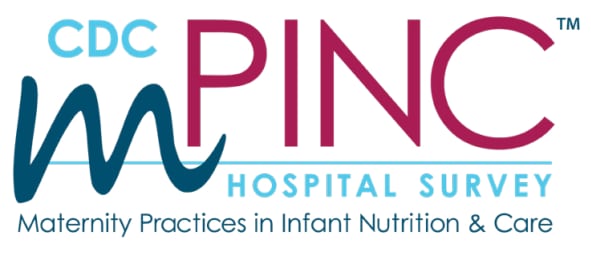At a glance
Learn about the national results report from CDC's 2024 Maternity Practices in Infant Nutrition and Care (mPINC™) Survey. Find what the survey measures, who is included in the results, and what the national subscores for each domain are.

About the 2024 mPINC survey
mPINC is CDC's national survey of Maternity Practices in Infant Nutrition and Care. The survey measures practices and policies in maternity care that support breastfeeding. Use mPINC data to bring together partners, identify gaps, celebrate achievements, and prioritize next steps.
The survey measures practices and policies that impact newborn feeding, feeding education, staff training and skills, and discharge support.
About every two years, CDC invites all hospitals with maternity services in the United States and territories to participate. In 2024, 2,070 of 2,657 eligible hospitals participated (78%).
National total score*: 82
*Scores range from 0 to 100, with 100 being the best possible score. The “Total Score” is an average of the subscores for the six domains. Learn more about how mPINC is scored.
Using data from CDC's 2024 mPINC survey, CDC reported that:
- Donor human milk was not available at 27% of advanced neonatal care units (ANCU) (Level II, III, and IV).
- Donor milk availability varied by level of care.
- 99% of hospitals with Level IV reported donor milk was available.
- 95% of hospitals with Level III reported donor milk was available.
- 50% of hospitals with Level II ANCUs reported donor milk was available. (Hospital special care nurseries).
- 99% of hospitals with Level IV reported donor milk was available.
Immediate postpartum care
National Subscore: 84
| Immediate Postpartum Care | % of Hospitals with Ideal Response |
|---|---|
| Newborns remain in uninterrupted skin-to-skin contact for at least 1 hour or until breastfed (vaginal delivery) | 71% |
| Newborns remain in uninterrupted skin-to-skin contact for at least 1 hour or until breastfed (cesarean delivery) | 50% |
| Mother-infant dyads are NOT separated before rooming-in (vaginal delivery) | 91% |
| Newborns are monitored continuously for the first 2 hours after birth | 74% |
Rooming-in
National Subscore: 77
| Rooming-In | % of Hospitals with Ideal Response |
|---|---|
| Mother-infant dyads are rooming-in 24 hours/day | 84% |
| Routine newborn exams, procedures, and care occur in the mother’s room | 33% |
| Hospital has a protocol requiring frequent observations of high-risk mother-infant dyads | 77% |
Feeding practices
National Subscore: 80
| Feeding Practices | % of Hospitals with Ideal Response |
|---|---|
| Few breastfeeding newborns receive infant formula | 27% |
| Hospital does NOT perform routine blood glucose monitoring on newborns not at risk for hypoglycemia | 94% |
| When breastfeeding mothers request infant formula, staff counsel them about possible consequences | 57% |
Feeding education and support
National Subscore: 95
| Feeding Education & Support | % of Hospitals with Ideal Response |
|---|---|
| Mothers whose newborns are fed formula are taught feeding techniques and how to safely prepare/feed formula | 80% |
| Breastfeeding mothers are taught/shown how to recognize/respond to feeding cues, to breastfeed on-demand, and to understand the risks of artificial nipples/pacifiers | 79% |
| Breastfeeding mothers are taught/shown how to position and latch their newborn, assess effective breastfeeding, and hand express milk | 76% |
Discharge support
National Subscore: 78
| Discharge Support | % of Hospitals with Ideal Response |
|---|---|
| Discharge criteria for breastfeeding newborns requires direct observation of at least 1 effective feeding at the breast within 8 hours of discharge | 68% |
| Discharge criteria for breastfeeding newborns requires scheduling of the first follow-up with a health care provider | 90% |
| Hospital’s discharge support to breastfeeding mothers includes in-person follow-up visits/appointments, personalized phone calls, or formalized, coordinated referrals to lactation providers | 90% |
| Hospital does NOT give mothers any of these items as gifts or free samples: infant formula; feeding bottles/nipples, nipple shields, or pacifiers; coupons, discounts, or educational materials from companies that make/sell infant formula/feeding products | 65% |
Institutional management
National Subscore: 77
| Institutional Management | % of Hospitals with Ideal Response |
|---|---|
| Nurses are required to demonstrate competency in assessing breastfeeding (milk transfer & maternal pain), assisting with breastfeeding (positioning & latch), teaching hand expression & safe formula preparation/feeding, and demonstrating safe skin-to-skin practices§ | 75% |
| Hospital requires nurses to be formally assessed for clinical competency in breastfeeding support/lactation management | 78% |
| Hospital records/tracks exclusive breastfeeding throughout the entire hospitalization | 92% |
| Hospital pays a fair market price for infant formula | 55% |
| Hospital has 100% of written policy elements§ | 31% |
